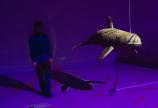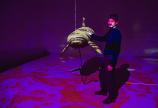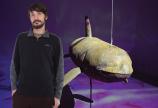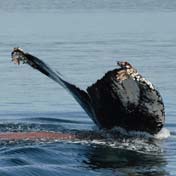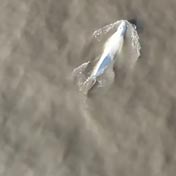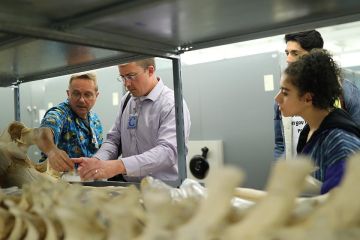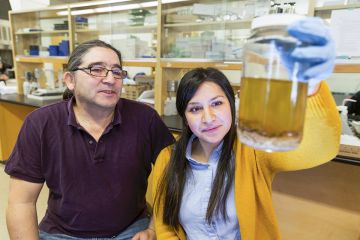When art meets science
- John Threlfall
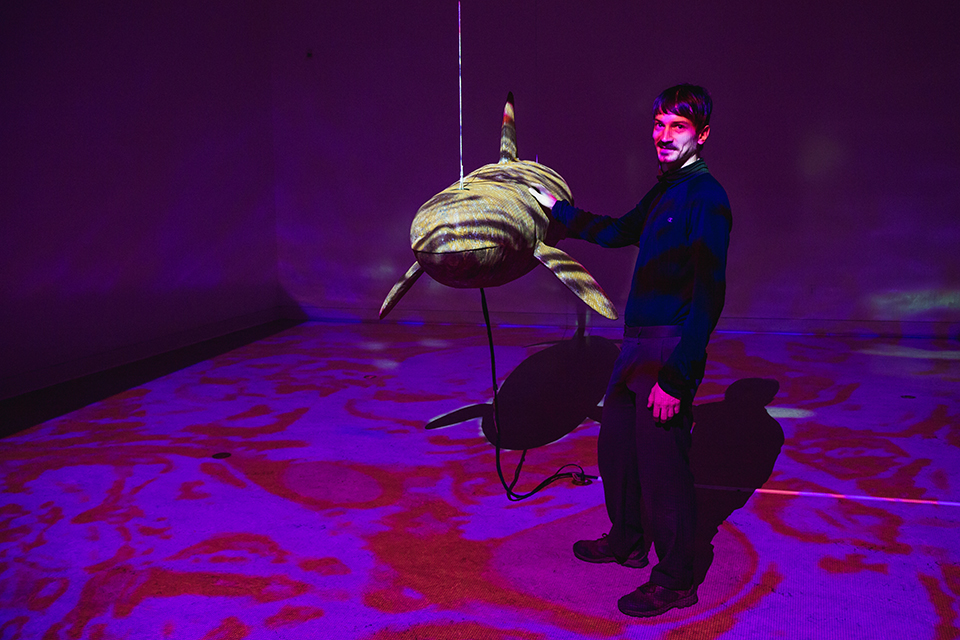
A student-created interactive orca sculpture fuses art, ocean data and climate change concerns
Ever wanted to have an intimate, interactive moment with a baby orca? A new student-created sculpture allows viewers to have just that, while also learning something about the threats currently facing our local killer whale population.
“Resonant Disintegration” is an intermedia installation created by University of Victoria undergraduate student Colton Hash. Featuring a life-size representation of three-year-old J53, the youngest surviving female of the endangered southern resident orcas, the eight-foot-long hollow sheet-metal sculpture is suspended by wires to simulate an aquatic environment.
After cutting, shaping and welding it, Hash then submerged the piece in a quiet bay off Esquimalt’s Saxe Point to achieve a rust-textured coating that allowed it to be “physically infused with a sense of local place and local water.”
But creating the physical sculpture was only half the concept. When installed, a projected visualization of climate data plays across the surfaces of both the whale and the room, while underwater recordings of passing freighters fill the space with a disturbing rumble.
“When people enter into the interactive space, their movements are recorded by a motion sensor and, as they approach the whale, the background noise and the speed of the climate data slows down, so they have somewhat of an intimate moment with the sculpture,” Hash explains.
Add in a microphone and another set of speakers playing the same sounds from inside the whale, all connected by a real-time computer program, and the whole effect becomes both beautiful and haunting.
“Because it’s a hollow object, it acts as a resonating chamber, and the contact microphone picks up vibrations that create a feedback loop and cause the sculpture to make its own sound,” says Hash. “Essentially, the sculpture is responding to underwater noises, as well as the interactions of the viewer.”
While visually appealing, Hash’s sculpture is firmly rooted in science—entirely appropriate, given that he’s also working toward a minor degree in environmental studies.
The project data is gathered from the Canadian Centre for Climate Modelling and Analysis located on the UVic campus. It includes variables such as precipitation, ocean temperatures and ground surface temperatures, all of which impact the health of different aquatic systems. The audio recordings are taken from UVic’s Ocean Networks Canada hydrophone stations in the Salish Sea.
“Climate change is happening and it’s already having devastating impacts on species we love, such as orcas,” says Hash. “This whole installation is an attempt to create a reflective and emotionally driven space where people can be present with their feelings. In this world of social media and information saturation, we’re not really allowing ourselves the time to reflect on how we’re feeling about the state of the world.
I've always loved sculptures honoring animals that are important to us. Obviously, there’s a lot of fascination with orcas around Victoria . . . but there’s a real disconnect between how they’re shown in art and the reality of their rapidly declining numbers.
—Colton Hash, undergraduate student and artist
While there are no immediate viewing dates lined up for the installation, Hash is hoping to exhibit it again in the near future.
“It offers the chance for people to engage spiritually and emotionally with the art and the issues,” he says. “Art has the ability to engage on those levels more than through intellectual or scientific information, which often seems overwhelming.”
EdgeWise
Only 76 orcas remain in the endangered southern resident killer whale population, which forages for chinook salmon in its core range off southern Vancouver Island. The primary cause of their decline is chronically low chinook numbers, although pollution and noise disturbance from vessels are contributing factors.
Three UVic researchers were recently awarded a total of $935,000 in federal funding to study the impact of underwater noise on southern resident killer whales and on the chinook salmon that make up almost 80 per cent of their diet. Read the story.
UVic’s Ocean Networks Canada operates world-leading cabled ocean observatories for the advancement of science and the benefit of Canada. These observatories collect data on physical, chemical, biological, and geological aspects of the ocean over longer time periods, supporting research on complex Earth processes in ways not previously possible.
UVic’s annual Department of Visual Arts BFA graduation exhibit will feature the work of over 45 emerging artists and showcase the exciting interdisciplinary work being created by students. The free exhibit runs 10 a.m. to 6 p.m. daily, April 20–28 in UVic’s Visual Arts Building.
Photos
In this story
Keywords: whales, film, arts, student life, oceans, wildlife, science
People: Colton Hash
Publication: knowlEDGE

